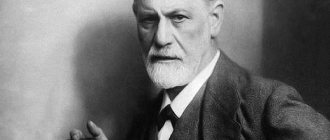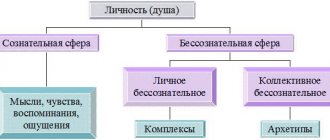According to Freud's theory, the process of personality formation begins at birth and goes through four stages. Each of these stages is associated with a specific area of the body - one or another erogenous zone (mouth, nose, ear, eye, anus, urethra, skin, navel).
On the basis of this idea, academicians V. Ganzen and V. Tolkachev developed vector psychology. This is the doctrine of eight vectors in a person’s character, called “applied system-vector psychoanalysis,” the essence of which boils down to the fact that a person cannot exist alone.
In system-vector psychology, a vector is a set of human qualities that form its system of values, morality, character, and behavioral characteristics. All vectors are innate and do not change throughout life. In this regard, each of these vectors sets a special scenario for a person’s life, and by studying them, you can understand what kind of person this person is and how to behave with him.
There are 8 vectors, that is, 8 types of human “direction”. The vector talks about what exactly a person likes, what kind of self-realization he is instinctively drawn to, what gives him pleasure. To realize his vector in society, a person plays a certain role in it. The name of the vector is identical to the human sensitive zone. So, let's begin:
Muscle vector.
General characteristics a) the color of greatest comfort is black
b) geometry of the greatest comfort - rectangle, brick;
c) place in a quartel - the inner part of the quartel SPACE, introvert - even double introvert
d) type of thinking - practical, involuntary-autistic, visual-effective.
Key task: monotonous physical work for progressive movement towards the goal. Species role: ordinary hunter or gatherer. Possible disadvantages: lack of motivation to improve work.
External signs
- Large build. “Man-mountain.”
- Stable (they say about someone like this: “Stands firmly on the ground”).
- Strong. Body with pronounced muscle relief.
- Wide, thick neck.
A person loves to work his muscles: a sport that allows you to build muscle mass; physical labor, namely carrying heavy loads, working in the field, with heavy equipment - is necessary for them. A person with a muscle vector in the absence of other vectors is a modest person with a minimum of needs and aspirations. Eating, a roof over his head, working, sleeping - the rest: science, art, entrepreneurship - are not for him. In combination with other lower vectors, it strengthens them, as if integrating into their desires and properties.
He doesn’t know how to make decisions, but he is a good performer - he is a follower. Muscular people are almost incapable of acting independently; they will do as they are told. They are unable to clearly express their own opinions; they simply follow the crowd. In their speech, instead of “I,” “we” appears. What a muscular man becomes depends on who is next to him.
Muscle plant perfectly adapts to a stable, unchanging rural landscape. Lives by the principle: as taught. This principle works in muscles in absolutely everything! Psychology of masses, crowds.
Physical labor is what it is necessary to teach a muscular child to do from an early age. He must help his parents; it is very important for him to learn to enjoy work. You need to understand that it is through muscle effort that the thinking of a muscular person is activated. He receives joy when he is engaged in physical labor, which in itself directs him in a peaceful direction. However, sports are strictly prohibited for such children, because they do not like to compete and win, they do not have such properties and data. Sport will only take them from the state of “peace” to the state of “war”.
Death is good for a muscleman; everything connected with life is suspicious for a muscleman, so a muscleman is suspicious of sex. A muscular woman creates a foundation, a foundation, giving birth to new offspring. She is the one who gives birth for real: she mowed the grass, went, gave birth under a haystack, and went on to mow. She gives birth to 10 children each so that there is a greater chance of survival. A muscular man has a contradiction - between life and death, which, however, is easily resolved through monotonous tradition and ritual: everything should be as it is with people, in a human way. When everything is not humane, then there is suspicion, because the program breaks down... not human, this is sex before marriage, sex of passion, breaking the monotony. Muscular men don’t walk around other people’s women.
An unrealized muscle vector often leads to fights and physical cruelty.
The realized muscle vector is physically strong and resilient people, manual workers, boxers, people performing monotonous physical work. Among people with a muscle vector there are often fans of sports games.
A muscular child feels very good in the womb like no other. It is connected to it through the umbilical cord as one whole - special meanings for the muscle vector. The muscular child in the womb resists birth with all its being. A newborn muscular child is fixed on the fact that everything was good in the mother’s stomach, all basic needs were satisfied on the spot and immediately, and life after birth is one suffering, since now everything must be done by yourself, on your own. These are “post-term” children, because they don't want to be born.
Muscular children are very flexible, they do not need special training. The most important thing is not to leave the muscular child hanging around and watch who he communicates with, otherwise there is a high probability that he will end up in the wrong company.
Without it, the existence of modern civilization would be impossible. One of the biggest and most important things that a person with a muscle vector does is construction.
Desired internal state: feeling like part of a mass of people.
Role in society: part of the “people”, worker, performer.
Phallic personality type
This type is formed when problems arise between three and six years of age associated with the emergence of children's interest in their new erogenous zones - the genitals, in the exploration of which he begins to show interest.
The phallic personality type is characterized by determination, persistence, assertiveness, self-confidence, turning into self-confidence, and determination. Men can be daring, boastful, their actions are often reckless, they strive for success, and their lives are spent constantly proving this success, often in love affairs like Don Juan. Women, like men, are prone to flirting, coquetry, have many men and, as it seems to them, all for love; they seem naive and innocent to themselves. Other women may acquire masculine character traits: persistence, determination, confidence.
Skin vector.
general characteristics
- the color of greatest comfort is khaki
- geometry of greatest comfort - cross
- place in the quartile – outer part of the quartile SPACE, extrovert
- type of thinking – logical, building cause-and-effect chains.
Key task: separating your space from the outside world, preserving and accumulating resources. Species role: commander of a group of hunters. In peacetime: creator and keeper of food supplies. Possible disadvantages: excessive control over the situation, stinginess.
External signs
He is not tall. Ideal, athletic body type: slim, flexible, fit. The lips of a leathernist are thin, tightly compressed - the upper lip is practically invisible.
A skinny woman is thin, lean, beautiful, swift, agile, flexible like a cat. Only a woman with skin gracefully holds space in stiletto heels - she moves beautifully and quickly in high heels. The skin gait is fast and dancing. The leather worker has an excellent sense of rhythm.
The skin person needs to think about diets less than others, but all he does is change one diet to another. Having gained a couple of extra pounds, the skinner begins to invent more and more restrictive diets for himself.
Kozhnik prefers a strict, business-like style of clothing at work and a sporty style of clothing outside of work. For men, a mandatory part of their wardrobe is a tie; a skinny woman also often uses this piece of clothing in her wardrobe. Favorite skin hairstyle: hair pulled back into a tight ponytail.
A skin gesture is an index finger that can be used to point, threaten, edify.
A leather worker's skin is delicate, sensitive, ideal, velvety. At a certain state of the vector, it is the skinners who apply tattoos to their bodies and give themselves piercings.
Kozhnik is very dexterous and flexible: he always accurately calculates his movements in space: he went around, ran around, and didn’t hit anyone.
In addition to a flexible body, a leather worker also has a flexible psyche. Its distinctive feature is the possibility of a 180-degree turn: today I will assert and prove one thing, and the next day with the same conviction - the opposite; The only question is what is more profitable for me to say at the moment. This allows them to easily and quickly adapt to any changing conditions, be it a change of job, moving to another city or even to another country. And thanks to a good analytical mind, they quickly process information. Skin type people will always be able to find their niche in a new environment. They know how to evaluate benefits, strive to increase efficiency, know how to save time and money, and get great pleasure from it. Their favorite word is “no.” However, this does not prevent them from agreeing after a while, having come up with a reasonable excuse. Skin people are mostly secretive, rarely answer questions, and do not express emotions.
An internal sense of time and space allows them to successfully do several things at once. Leather workers are focused on success, including material success. Career, wealth, social status make up the system of value guidelines of a skin person. Only he knows the ambitions and desire to be a leader, because... he loves competition. It could be sports, competition in business or love.
Logic and logical thinking are also a distinctive feature of leather workers. In their speech you can often hear the phrases: “This is not logical! Where is the logic here? It would be logical to assume”, etc.
A child with the skin vector is very active, often disobedient. Caught in some kind of prank, he will be cunning and dodge. The right approach to education will allow a leather worker to become a successful businessman or engineer in the future.
Skin children who were constantly beaten and humiliated in childhood receive psychological trauma, adapting to this pain, and the body begins to release endorphins to drown it out. Gradually, the child gets used to this kind of effect, and then becomes dependent on it, receiving specific pleasure from it. This is how masochism arises. If such a person in adulthood does not receive the usual endorphins through physical pain in sexual life, then the desire to experience pain through social frustrations and failures appears. This is how a life scenario for failure develops, a person turns into an eternal loser.
Desired internal state: a feeling of being busy, the skinner is always in motion, in development, in changes and new information.
Role in society: breadwinner, organizer, middle manager, coordinator, defender.
Anal personality type
At the age of one and a half to three years, the child begins to be toilet trained, to the first forms of self-control, and depending on how this happens (under conditions of frustration or in an atmosphere of caring), two types of personality are obtained: anal-retaining and anal-pushing.
The anal-retentive personality type is characterized by stubbornness, stinginess, excessive neatness, and punctuality. He likes to plan his behavior to the smallest detail and does not like disorder and uncertainty.
The anal-thrust personality type is characterized by impulsiveness, a tendency to worry and destruction, and sometimes to cruelty.
Olfactory vector.
general characteristics
- the color of greatest comfort is purple
- geometry of greatest comfort - zigzag
- place in the quartel – inner part of the ENERGY quartile, introvert
- type of thinking – intuitive; strategic
- people with the olfactory vector are less than 1%.
Key challenge: identifying potential hazards before they become real. Survive at all costs. Species role: shaman, sorcerer , adviser to the leader, strategic intelligence officer, eminence gray. Possible disadvantages: excessive suspicion, distrust of others.
Freud and his brainchild
However, even those specialists who disagree with the main tenets of Freudianism must recognize the enormity of his contribution - regardless of how many theses in Freud's works require verification and addition. After all, it was he who was the first to manage to study in detail and as honestly as possible the “animal called man.” Freud openly admitted that every person has to face the same question - how to live in civilization. After all, it is both the most amazing achievement of humanity and its colossal tragedy.
Civilization requires everyone to restrain their desires and passions. Freud did not wear “rose-colored glasses” - he looked soberly at how a person lives under these restrictions. It was Freud who first noted the negative aspect of upbringing and education. Adults dictate to the child what he can do and what he cannot even imagine. Despite the fact that Freud methodically destroyed all his biographical notes and letters, he was always ready to try on his own theory of psychoanalysis.
The scientist noted that very few people are able to openly admit such things that do not leave their reputation unnoticed. Therefore, often, while recording his most revealing dreams and difficult childhood memories, Freud often repented of such self-exposure. “Those who want to reproach me for such secrecy, let them try to be more frank than me,” the scientist wrote.
Conclusion
The ongoing debate about the validity of Freud's theory of personality development should come as no surprise. It should come as no surprise that most people defend themselves against Freud's incriminating concepts. Freud himself believed that he was destined by fate to interrupt the “sleep” of humanity and tell them such an unpleasant truth about himself. As the great psychiatrist once told the writer Zweig, the main task of his theory is to teach a person to fight the “demon of irrationality”, while using the most rational principles of his mind.
Freud was very proud of his reputation as a “destroyer of illusions.” The product of his research work - psychoanalysis - became the main enemy of the deceitful politeness and secrecy of the society of that time. In 1930, in a letter to Albert Einstein, Freud wrote: “I no longer consider it one of my virtues that I always tell the truth whenever possible; it became my profession.”
Topics: Child psychology, Personal growth, For parents
Why is psychoanalysis criticized?
Initially, Freud's developments were accepted by I. S. Kudryashov. Psychoanalysis and its prerequisites. Journal of Siberian Medical Sciences. with hostility, and his concept was accompanied by scandalous fame. In particular, it was opposed by A. Grünbaum. One Hundred Years of Psychoanalysis: Results and Prospects. Independent Psychiatric Journal. Karl Jaspers, Arthur Kronfeld, Karl Popper and Kurt Schneider.
Although today the concept of psychoanalysis has many supporters, it is subject to serious criticism. Opponents of psychoanalysis doubt its effectiveness, and some researchers even declare Tallis RC Burying Freud. The Lancet. Freudian concept of pseudoscience.
A hot topic of criticism has been the concentration of psychoanalysis on sexual motives. For example, a number of researchers believe Kraepelin E. Introduction to the Psychiatric Clinic. M. 2004. that “rough digging into the sexual life” of patients can lead to adverse consequences for the psyche.
Disputed Kupfersmid J. Does the Oedipus complex exist? Psychotherapy: Theory, Research, Practice, Training. and Freud's concept of the Oedipus complex.
There is also Svartberg, M., Stiles, TC Comparative effects of short-term psychodynamic psychotherapy: a meta-analysis. Journal of consulting and clinical psychology. doubts about the effectiveness of psychoanalytic therapy. In 1994, a group of German scientists conducted Hoffmann-Richter U. Psychotherapie im Wandel - Von der Konfession zur Profession. Eine Auseinandersetzung mit einem bemerkenswerten Buch von Klaus Grawe, Ruth Donati und Friederike Bernauer. Psychiatric Praxis. study of 897 works on psychoanalysis. Scientists have concluded that long-term visits to a psychoanalyst are not effective for the patient and that psychoanalytic therapy increases the risk of worsening his condition. Only some mild disorders, according to the article, partially recede after psychoanalysis sessions. At the same time, behavioral therapy was twice as effective.
NotedAckerman CE Psychoanalysis: A Brief History of Freud's Psychoanalytic Theory. Positive Psychology. also that the hypotheses and provisions of psychoanalysis are difficult to test experimentally, since this approach pays too little attention to the conscious in human behavior.
Psychoanalytic theory has also been criticized for its roots in Freud's sexist views, its inapplicability to non-Western cultures, and its excessive tendency to reduce everything to pathologies.
Opponents also criticize the methods of psychoanalysis. For example, psychologist Burres Frederick Skinner considered McLeod S. Psychoanalysis. Simply Psychology. The "ink blot" method is subjective and unscientific.
In addition, Freud himself is reproached by A. M. Rutkevich. How Freud adjusted the facts to his theory. Psychoanalysis. Origins and first stages of development: Course of lectures. M. 1997. in the manipulation of facts. In 1972, Canadian psychiatrist and medical historian Henry Ellenberger found out Ellenberger HF The story of “Anna O”: A critical review with new data. Journal of the History of the Behavioral Sciences. that there was no improvement in “Anna O.” Did not happen. That is, the very first case of cure using psychoanalysis actually turned out to be a fake. Subsequent studies established Rutkevich A. M. How Freud adjusted the facts to his theory. Psychoanalysis. Origins and first stages of development: Course of lectures. M. 1997. that Breuer stuffed the patient with morphine and chloral hydrate, ultimately making her a drug addict. Because of this, she spent another three years recovering from the consequences of “catharsis.”
Today it is known that “Anna O.” sufferedBorsch-Jakobsen M. Souvenirs d'Anna O. Une mystification, centenaire. Paris. 1995. from dental disease. Freud’s own patient, “Cecilia M.”, also had the same illness. (Anna von Lieben), whom he persistently diagnosed as hysterical neurosis. It is also worth mentioning here the illustrative case of “Dora” (Ida Bauer). Freud believed that her pain was associated with nervous experiences, although in fact Ida was tormented by rectal cancer.
There are also subjective factors. McLeod S. Psychoanalysis. Simply Psychology., which make it difficult to determine whether psychoanalytic therapy is effective or not.
- It requires a lot of time, money and motivation and does not guarantee a quick “recovery”.
- During sessions, a person can reveal repressed painful memories, which will cause him even greater suffering.
- Psychoanalysis is not suitable for all people and not all illnesses.
However, there is Safran JD Psychoanalysis Today. Psychology Today. and the opposite point of view. For example, Canadian-American psychologist Jeremy Safran believes that some methods of psychoanalysis in conjunction with modern research have proven effective. And the American Psychological Association includes Psychoanalysis. APA. psychoanalysis is among its recognized practices and areas of specialist training.
Levels of consciousness according to Freud
Freud divided the psyche into three levels - preconscious, conscious and unconscious. He is also the author of the division of personality into three components - “I”, “Super-I” and “It”. The preconscious level can perceive information with proper concentration. It refers to threshold perception. Memories fall into this category. People do not remember them every second, but with effort, these images will immediately appear in their imagination. Freud's theory of personality development assigns consciousness the role of “a sense organ for the perception of mental qualities.” But what interested him most was the unconscious. It is this that accommodates the natural needs of the body - primarily aggression and sexual energy.
Freud also divided human personality into three components. The "It" or "Id" is the most primitive of them. This part is located in the unconscious and exists on the principle of pleasure. It is here that the drives are contained - the instinct for life, called "Eros", and the instinct for death, "Thanatos". Personal development draws its energy from this part of the psyche.
How psychoanalysis influenced the development of psychology
During the 20th century, psychologists borrowed many of Freud's ideas and observations. This is especially true for T. S. Martynenko, A. S. Deinekina. The influence of psychoanalysis on modern psychotherapy. North Caucasian Psychological Bulletin. concepts of levels of consciousness, defense mechanisms and stages of psychological development.
Thus, before Freud, dreams were considered a phenomenon not worthy of scientific attention. However, his book “The Interpretation of Dreams” and the concept outlined in it aroused intense interest in this area of human life, which continues to this day.
Freud's further developments were used by Psychoanalysis. Encyclopaedia Britannica., for example, to create the theory of child psychoanalysis. Pioneers in this area were Melanie Klein and Anna Freud, daughter of Sigmund Freud.
In a slightly different form, Freud's work was continued by Ackerman CE Psychoanalysis: A Brief History of Freud's Psychoanalytic Theory. Positive Psychology. his student Carl Jung, creator of analytical psychology. He disagreed with the teacher on the nature of libido (the energy underlying human aspirations and actions) and the unconscious, as well as the causes of human behavior.
Freud viewed libido only as a source of sexual energy, while Jung argued that it was much broader and included motives from sex to creativity.
Also, Jung did not share Freud's idea that human behavior is dictated only by past experience. He believed that future aspirations also played a significant role.
Jung's work underlies most modern psychological theories and concepts. For example, he introduced Brenner GH What Is Psychoanalysis? Psychology Today. into circulation such well-known terms as “personality archetypes” and “collective unconscious”.
In the middle of the last century, psychoanalysis entered into close interaction with the arts, humanities and philosophy. For example, he provided Elkan O. B., Putra V. A. The influence of psychoanalysis on the cinema of the twentieth century. Bulletin of Tomsk State University. Cultural studies and art history. a great influence on German expressionism, which, in turn, largely determined the emergence of the horror film genre. Freud's concept greatly influenced the work of such directors as Alfred Hitchcock, Federico Fellini, Michelangelo Antonioni, Paolo Pasolini. Freudianism also plays a significant role in the films “Basic Instinct”, “Eternal Sunshine of the Spotless Mind”, “Antichrist”, “Shutter Island”.
Look








